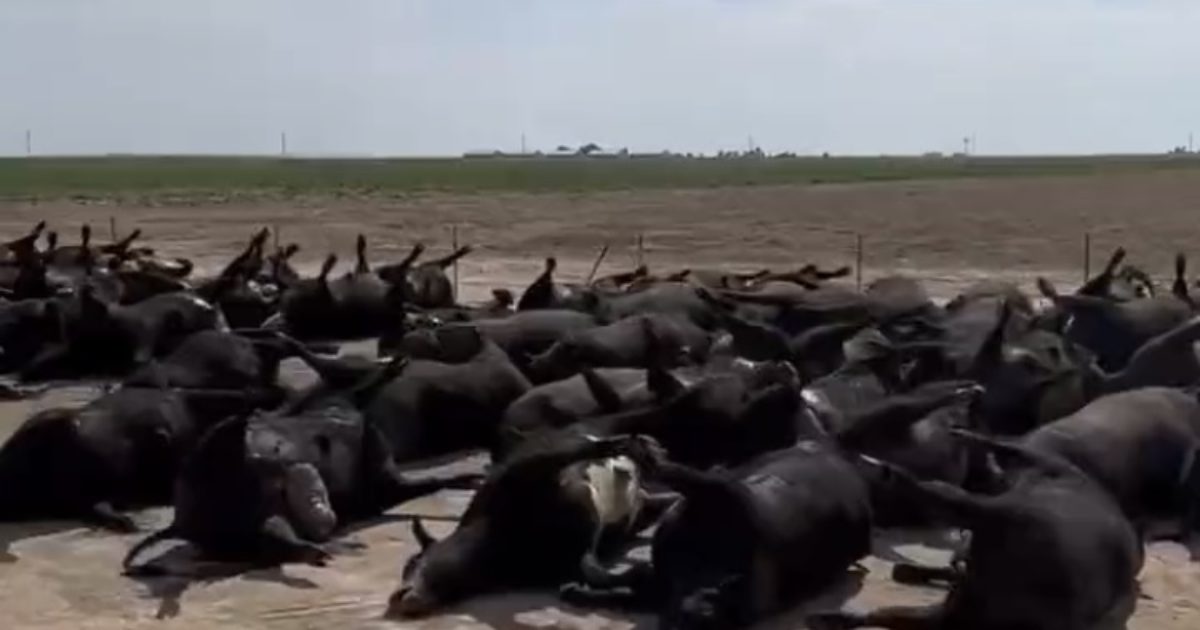The current heat wave in Kansas has reportedly killed an estimated 10,000 head of fat cattle.
While the final tallies are still coming in, the early estimate was made by livestock experts, who pointed to Ulysses, Kansas as the geographical center for the deaths.
Multiple Kansas feedlots were reportedly hit by a string of scorching temperatures this week, resulting in the loss of thousands of head due to heat stress.
DTNPF wrote:
What is known is that leading up to these heartbreaking losses, temperatures in the area were over 100 degrees Fahrenheit, there was humidity, and there was little to no wind to help cool the animals. Temperature readings reported for Ulysses began to exceed the 100-degree mark on June 11. By June 13, the high temperature was reported at 104 degrees, with humidity levels ranging from 18% to 35%. Temperature and humidity levels began to break some on June 14. Just a few days prior to the heat setting in, highs had been in the 80s.
Corbitt Wall, a cattle analyst with National Beef Wire who works out of Amarillo, Texas, told DTN he heard from two non-media sources about the extent of the Kansas losses. He noted there was frustration that despite such extensive losses, the futures market fell Monday.
“I know it’s hard for people in the business to watch that futures market, but it’s not real,” he said. “The only time those traders and speculators make money on futures is when the market is volatile, and they are watching these algorithms to tell them where the market is going. For people following the fundamentals, it is frustrating.”
But is there potentially another cause to these string of cattle deaths besides heat stress?
One farmer in southwest Kansas allegedly said it wasn’t the heat that killed the cattle.
This alleged video from Kansas shows a string of cattle that recently died.
https://twitter.com/buperac/status/1536908506023878656?ref_src=twsrc%5Etfw%7Ctwcamp%5Etweetembed%7Ctwterm%5E1536908506023878656%7Ctwgr%5E%7Ctwcon%5Es1_&ref_url=https%3A%2F%2Fcitizenfreepress.com%2Fbreaking%2F10000-cattle-die-in-kansas-heat%2F
Can anyone confirm that this is a current video from SW Kansas? https://t.co/UHl5AF1xT7
— Grace 🔎 (@reallygraceful) June 15, 2022
https://twitter.com/SatansFlesh/status/1536913249907552256
Veterinarian A.J. Tarpoff said it would take a “perfect storm” of too much heat and no opportunity for nighttime cooling for cattle to accumulate heat and die from the stress.
“Heat stress doesn’t happen all at one time. Cattle accumulate heat during the day, and then over the nighttime hours, it takes four to six hours for them to dissipate that heat. As long as we have a cooling effect at night, cattle can mostly handle the heat. Where we run into issues is where we have two to four days in a row of minimal nighttime cooling, and we start the day with the heat load we accumulated the day before still there,” he said.
https://twitter.com/buperac/status/1536916064239353856
Nope. As mentioned I live in the Sonoran desert Arizona. Heat upwards of 115% and dry. Dairy farms all over. never a mass death like this. Something besides heat & a virus is NOT going to kill a herd at once like this. They look healthy. Poisoning would be my only guess.
— Liz-Taylor.XRP (@Liz85139) June 15, 2022
https://twitter.com/buperac/status/1536913408448024576
While the cause of death is still being investigated, there’s a peculiar facility located in Kansas that raises red flags.
The U.S. Department of Agriculture (USDA), in conjunction with the U.S. Department of Homeland Security (DHS), developed a new National Bio and Agro-Defense Facility (NBAF) in Manhattan, Kansas.
“This state-of-the-art facility will be a national asset that helps protect the nation’s agriculture, farmers and citizens against the threat and potential impact of serious animal diseases,” the USDA stated.
Couldn’t be because of a new biolab could it? https://t.co/MknCaZQ7mX
— Orwell Huxley’s Ghost (@Tinkeringhalo2) June 15, 2022
From the DHS:
The National Bio and Agro-Defense Facility (NBAF) will be a state-of-the-art biocontainment laboratory for the study of diseases that threaten both America’s animal agricultural industry and public health. DHS S&T is building the facility to standards that fulfill the mission needs of the U.S. Department of Agriculture (USDA) which will own, manage and operate (PDF, 16pp, 165 KB) the NBAF once construction and commissioning activities are complete. The NBAF will strengthen our nation’s ability to conduct research, develop vaccines, diagnose emerging diseases, and train veterinarians. The NBAF will be a national security asset and will meet the needs of the homeland security mission.
The United States currently does not have a laboratory facility with maximum biocontainment (BSL-4) space to study high-consequence zoonotic diseases affecting large livestock. The NBAF will be the first laboratory facility in the U.S. to provide BSL-4 laboratories capable of housing cattle and other large livestock. The NBAF will also feature a vaccine development module. For more information about the facility and intended use of its state-of-the-art features, please visit the USDA NBAF Program website.
DHS S&T leads construction activities for NBAF which remain underway. Current operations at the Plum Island Animal Disease Center (PIADC) will continue until the mission is transitioned to the NBAF.
The federal government will execute a plan to provide for seamless transition of the agricultural defense mission from PIADC to the NBAF that includes an overlap of operations to make certain there is no interruption of the critical science mission and operational capabilities.
In January 2020, USDA and DHS S&T signed a Memorandum of Understanding (MOU) to outline their ongoing strategic interagency partnership at NBAF focused on national security.
“As of January 2022, the $1.25B NBAF project is approximately 98 percent complete. The facility’s main laboratory construction and commissioning activities were initiated in May 2015. The laboratory will not open until all necessary permits and registrations are received. On June 20, 2019, officials from the USDA and DHS signed a Memorandum of Agreement (PDF, 16pp, 165 KB) that formally outlined how the departments will transfer ownership and operational responsibility for the NBAF from the DHS Science and Technology Directorate to USDA,” the DHS stated.



Join the conversation!
Please share your thoughts about this article below. We value your opinions, and would love to see you add to the discussion!